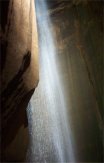
June Editorial

June Editorial
Ruby Falls |
|
This month's editorial takes us to Lookout Mountain in Tennessee to visit one of the world's largest underground waterfalls - the Ruby Falls. The original Lookout Mountain cave under which the Ruby Falls lies had a natural entrance on the banks of the Tennessee River. This was permanently closed in 1905 following the construction of a railroad tunnel through the mountain. A Mr Lambart, an enthusiast cave explorer, raised the money twenty years later to buy the land above the original cave. He intended to drill a shaft from the top of the mountain into the cave and install a lift which would allow visitors back to the cave. During the drilling a small opening was found which Mr Lambart decided to explore. He found a new cave which he described as having many beautiful rock formations and a 145-foot waterfall which he named “Ruby Falls” after his wife. The uncovered Lookout Mountain cave structure actually consists of two caves. The lower cave is about 50 feet above the level of the Tennessee River and has no formations. The upper cave, which contains Ruby Falls lies directly above the original cave, but has no physical connection to it. The water from Ruby Falls flows back through the cave and then down another waterfall into the Tennessee River. Ruby Falls is located in the limestone (Limestone is sedimentary rock composed mainly of calcite (CaCO3)) layer of the mountain. Most caves are formed from limestone by a slow process which combines chemical weathering (A process which breaks down rocks by the action of naturally forming chemicals - mostly carbonic acid) and physical weathering, which is the actual breaking of rocks by wind, water, or plants which gradually dissolves the limestone. In addition to a wonderful waterfall, the cave is well known for many different types of rock formations. All of these formations are of calcium carbonate that has crystallized as calcite. The most common are stalactites, stalagmites, and columns. Stalactites are caused by water containing minerals such as calcium carbonate dripping down from the ceiling and leaving ever-lengthening deposits. Stalagmites are pillar-like formations that develop upward from the floor of the cave as mineral-rich water drips into them. Columns are formed when stalactites and stalagmites fuse together.
Other commonly found formations in Ruby Falls are: Helictites which are type of stalactites which are distorted and twisted due to crystals of calcite that are not arranged in any symmetrical order; curtains or drape formations - thin strips of calcite sheet formed when water flows down the inclined ceiling of a cave; and flowstones - thin sheets of calcite on the walls or ledges of the cave caused by precipitation of calcite on the flat surface.
|
| _______________________________ | ||||
| Home | | | Shopping | | | Database |
© Biscuit Software 2004-2015
All rights reserved